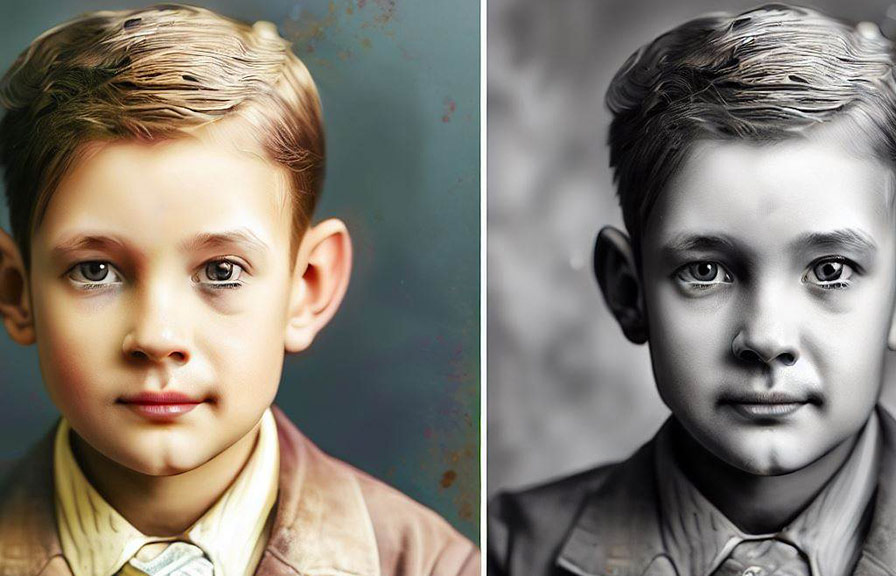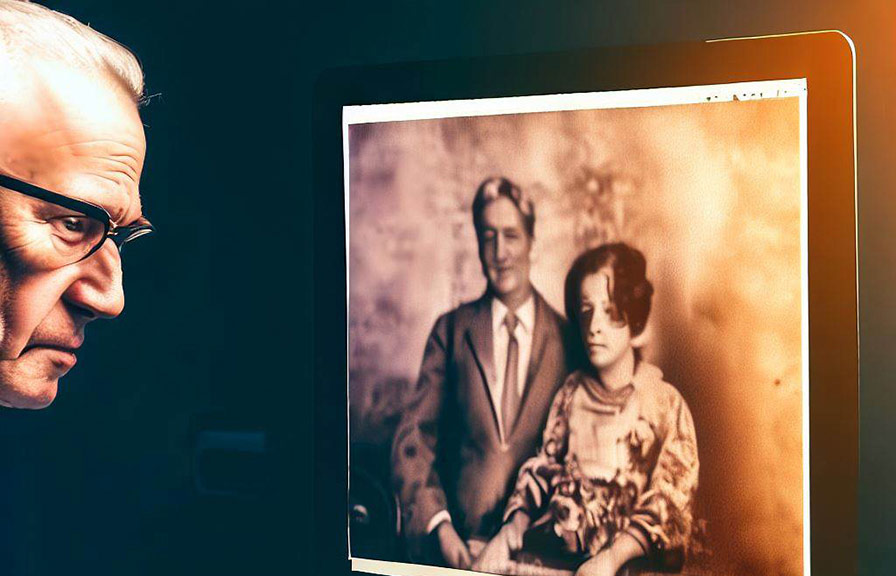Introduction
Preserving our family history is like holding a time capsule filled with cherished memories. it allows us to connect with our ancestors, understand our roots, and pass down a rich legacy to future generations. Among the various means of preserving our family history, one powerful method stands out: restoring and colorizing old photos.
These faded, worn-out images hold countless stories and emotions that deserve to be revived and shared. in this blog post, we delve into the significance of photo restoration and explore how it plays a vital role in preserving our family heritage.
Photorelive can do the Photo Restoration job for an affordable price restoring and colorizing your old photos professionally.

What is photo restoration?
Photo restoration is a captivating art that breathes new life into old and damaged photographs. it is a meticulous process that involves reviving the vibrancy, clarity, and overall quality of these treasured visual artifacts. by utilizing advanced techniques and tools, photo restoration allows us to transcend the limitations of time and restore the beauty of bygone eras.
At its core, photo restoration seeks to preserve the essence and historical value of these images, ensuring they remain intact for future generations to admire and cherish. whether it's a faded black and white portrait or a torn sepia-toned family photo, the goal of restoration is to rejuvenate these relics and unveil the stories they hold.
How does photo restoration work?
Photo restoration is an intricate process that combines artistry, technical skills, and the power of modern technology. skilled restoration artists carefully analyze each photograph, assessing the extent of damage, discoloration, and deterioration. with a keen eye and expert knowledge, they employ various methods to breathe new life into these images.
Advanced software tools, like adobe photoshop, have revolutionized the field of photo restoration. these digital wizards allow restoration artists to manipulate and repair the tiniest details with precision. by utilizing techniques such as color correction, retouching, and reconstruction, they meticulously reconstruct missing areas, remove scratches or stains, and enhance the overall quality of the photo.
The role of technology, particularly software like photoshop, cannot be overstated in the photo restoration process. it provides restoration artists with an extensive range of tools and filters that aid in the meticulous transformation of faded memories into vibrant visual narratives.
Photo restoration is truly a labor of love that requires both technical expertise and a deep appreciation for the emotional value of these family heirlooms. it is an art form that honors the past while securing its place in the future.
Next, we delve into a common question: Can old damaged photos be restored?
Iii. can old damaged photos be restored?
A. addressing the common concern
When faced with damaged and deteriorated photos, it's natural to wonder if restoration is even possible. the good news is that, in most cases, old damaged photos can indeed be restored. while the extent of restoration depends on the severity of the damage.
Professional restoration techniques can work wonders in reviving even the most worn-out images.
B. factors influencing the restoration process
Several factors come into play when restoring old photos. the type and extent of damage, the age and condition of the photograph, and the available resources all influence the restoration process. minor issues like small scratches, fading, or discoloration are relatively easier to address.
On the other hand, more severe damage, such as missing portions, deep tears, or water damage, may pose greater challenges.
Additionally, the expertise and skills of the restoration artist play a significant role. experienced professionals have honed their techniques and possess a deep understanding of the restoration process, allowing them to tackle complex restoration projects with finesse.
C. limitations and challenges in restoring severely damaged photos
While restoration techniques have advanced significantly, there are limitations when it comes to extremely damaged photos. in cases where the image is severely torn, heavily faded, or missing crucial elements, restoration may be more challenging. however, even in such instances, skilled restoration artists can often work miracles, leveraging their expertise to reconstruct missing areas and breathe new life into the photograph.
It's essential to consult with a professional restoration specialist who can assess the condition of your damaged photo and provide an accurate evaluation of what can be achieved.
Iv. benefits of photo restoration
A. preserving family memories for future generations
Photo restoration ensures that the memories captured in old photos remain intact and accessible to future generations. by preserving these images, we pass on our family stories, traditions, and the legacy of our ancestors, creating a bridge that connects the past with the present.
B. enhancing the visual quality of old photos
Time takes a toll on photographs, causing them to fade, lose color, and suffer from other forms of damage. through restoration, we can bring back the original vibrancy and clarity of these images, making them visually stunning once again.
The process involves color correction, retouching, and other techniques that revitalize the photo, allowing us to appreciate its beauty as intended.
C. rediscovering details and bringing historical moments to life
Old photos often hold hidden details that become obscured over time. restoration brings these details back into focus, allowing us to rediscover nuances, expressions, and subtle features that may have been overlooked. it's like unveiling a window to the past, where historical moments come alive through the restored photo.
D. strengthening the emotional connection to family heritage
Restored photos have a way of evoking powerful emotions. they serve as tangible links to our family heritage, connecting us with our roots and strengthening our emotional ties. seeing the faces of our ancestors in clear, vibrant images can ignite a deep sense of belonging and ignite a passion for preserving our family history.
E. facilitating easy sharing and digital preservation
Restored photos can be easily shared with family members near and far. by digitizing the restored images, we can create digital archives that can be stored, shared, and accessed conveniently. this digital preservation ensures that our family history remains secure and easily accessible for future generations to explore and appreciate.
As we've explored the benefits of photo restoration, you might wonder how you can embark on your own restoration journey. in the next section, we'll guide you through the process of restoring and repairing old photos.
V. how to restore and repair old photos
Restoring and repairing old photos requires a systematic approach to ensure the best possible results. here's a step-by-step guide to help you embark on your own photo restoration journey:
1. Assessing the condition of the photo begin by carefully examining the photo to determine its overall condition and the extent of damage. take note of any tears, scratches, fading, or discoloration. this assessment will help you understand the specific areas that require attention during the restoration process.
2. digitizing the photo to work on the restoration digitally, you need to create a high-resolution digital copy of the original photo. use a flatbed scanner or a professional scanning service to capture the image at the highest possible resolution.
This digital copy will serve as your working file for restoration, preserving the original photo in its current state.
3. cleaning the physical copy (if applicable) if the original photo is physically dirty or dusty, you can carefully clean it before proceeding. use a soft, lint-free cloth or an archival-quality brush to gently remove loose dirt or debris. be cautious not to apply excessive pressure or use any harsh cleaning agents that might damage the photo further.
4. utilizing software like photoshop for restoration with the digital copy of the photo at hand, it's time to utilize software like adobe photoshop for the restoration process.
open the image in photoshop and familiarize yourself with the tools and techniques available for restoration.
These may include spot healing brushes, clone stamp tools, and content-aware fill, among others.
5. adjusting color, contrast, and sharpness begin the restoration by addressing color issues, if any. adjust the color balance, saturation, and hue to restore natural tones or enhance the photo's aesthetic appeal. next, focus on improving the contrast and sharpness of the image.
Use photoshop's adjustment layers or tools like levels, curves, and sharpening filters to refine the overall tonal range and bring out details.
6. saving and preserving the restored photo once you're satisfied with the restoration, it's crucial to save your work in a high-quality format. consider saving the restored photo as a tiff (tagged image file format) or a high-quality jpeg to retain as much detail as possible.
Keep both the original scanned file and the restored version in secure digital storage to ensure long-term preservation.
Remember, photo restoration is a skill that takes time and practice to master. if you encounter complex restoration challenges or have valuable photos that require special attention, it's advisable to seek professional assistance to achieve the best possible results.
In the next section, we address another common question: can damaged photos be fixed?
Vi. can damaged photos be fixed?
A. extent of photo repair
The extent to which damaged photos can be repaired largely depends on the severity and nature of the damage. minor damages such as small tears, scratches, or mild discoloration can often be successfully fixed through restoration techniques.
Skilled restoration artists can employ various tools and methods to seamlessly mend these imperfections, resulting in a significantly improved image.
B. differentiating minor and major damages
It's important to differentiate between minor and major damages when assessing the repairability of a photo. minor damages are those that have not significantly affected the overall composition or content of the image. these damages are typically localized and do not compromise the crucial elements or details of the photograph.
In contrast, major damages involve extensive tearing, missing portions, severe fading, or water damage that has significantly affected the image's integrity.
While minor damages can often be addressed effectively, major damages may require more advanced restoration techniques or even professional intervention. it's crucial to set realistic expectations and understand that there may be limitations to what can be achieved with severely damaged photos.
C. seeking professional assistance for complex restoration projects
For complex restoration projects or valuable photos with major damages, it's highly recommended to seek professional assistance. experienced restoration specialists possess the expertise, advanced tools, and techniques necessary to tackle intricate restoration challenges. they can carefully assess the photo's condition and develop a tailored restoration plan to achieve the best possible results.
Professional restoration services can handle complex repairs, including extensive reconstruction, color correction, and meticulous retouching. they can leverage their skills to preserve the integrity of the original image while breathing new life into it. collaborating with restoration experts ensures that your cherished photos receive the attention they deserve, enabling you to preserve your family history with the utmost care and precision.
Conclusion
Restoring and colorizing old photos holds immense significance in preserving our family history. through photo restoration, we can revive and safeguard cherished memories for future generations to appreciate. by utilizing advanced techniques, such as repairing minor damages and enhancing visual quality, we can bring historical moments to life and strengthen our emotional connection to our family heritage.
We encourage youto take action and embark on your own photo restoration projects. whether you're restoring faded portraits, repairing damaged family snapshots, or colorizing black and white images, the process allows you to honor your past and ensure its lasting legacy.
The benefits of photo restoration go beyond mere visual improvement; they touch the core of our emotions and bring us closer to our roots.
As you embark on your restoration journey, remember to set realistic expectations, seek professional assistance for complex projects, and enjoy the transformative process of reviving and preserving your family history. embrace the power of restoration, and let your family's story shine through the images that encapsulate its essence.
